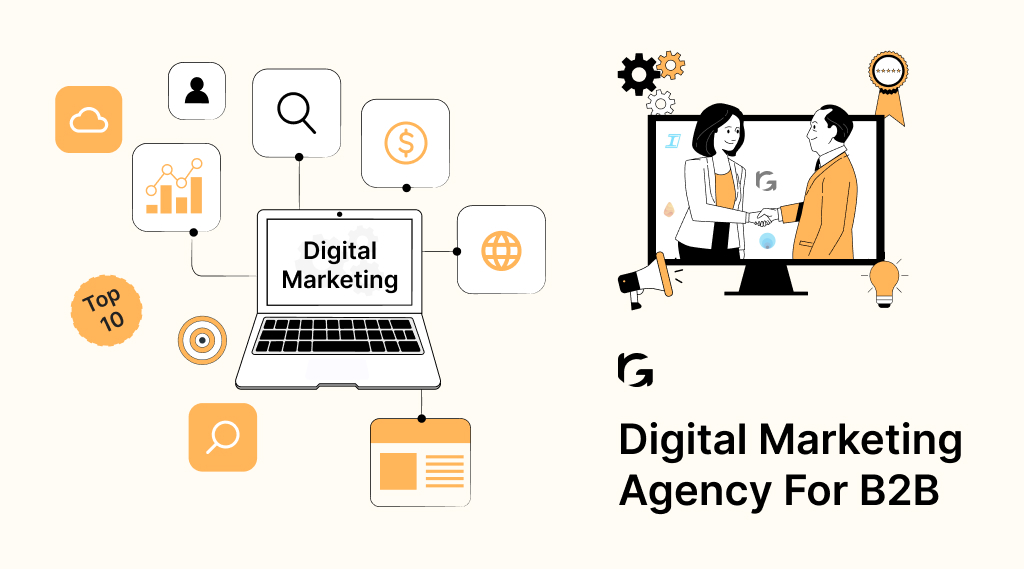Running a B2B business means facing daily challenges to boost growth, find leads, and increase sales. Dealing with B2B social media marketing and incorporating growth marketing strategies adds another layer of complexity.
While you’ve heard about its potential, navigating different platforms, changing algorithms, and the pressure to create the perfect post can be overwhelming.
You might be wondering, “How can I stand out and connect with my target audience effectively? How do I create real business results from genuine engagement?”
If these questions sound familiar, you’re not alone.
This blog post is for ambitious business owners ready to dive into B2B social media marketing and explore growth hacking techniques. Let’s simplify things and get started.
What is B2B social media marketing?
B2B social media marketing is when businesses use social platforms like LinkedIn, Twitter, or Facebook to promote their products or services to other businesses.
It’s like regular social media but tailored for companies instead of individual consumers. B2B marketing aims to connect with other businesses, share valuable information, and build professional relationships online.
The goal is to generate leads, increase brand awareness, and ultimately boost sales by engaging with potential business clients on social media.
Why is social media so valuable for b2b companies?
Social media has become a game-changer for B2B companies, providing immense value and opening up new avenues for business growth. Let’s explore why social media is so valuable for B2B companies in simple terms.
1. Building brand awareness
Social media helps B2B companies reach a wider audience, making them visible to potential clients. For instance, LinkedIn allows businesses to showcase their expertise through regular posts and updates.
This exposure helps in creating a positive impression and establishing the brand as an industry leader.
2. Connecting with decision-makers
On platforms like LinkedIn and Twitter, B2B companies can directly engage with decision-makers in other businesses. This direct interaction allows for meaningful conversations, making it easier to pitch products or services.
For example, a company can tweet a concise message to a potential client, initiating a connection that may lead to future collaborations.
3. Showcasing products and services
Social media provides a visual platform for B2B companies to showcase their products or services. Platforms like Instagram and Pinterest allow for the creation of visually appealing content.
A B2B company manufacturing industrial equipment, for instance, can share high-quality images and short videos demonstrating its products, making it easier for potential clients to understand and appreciate what it offers.
4. Staying informed about industry trends
B2B companies can use social media to stay updated on industry trends, market changes, and competitor activities. By following relevant hashtags and industry influencers on platforms like Twitter, companies can quickly gather valuable information.
For instance, a software development firm can track trending topics to understand the latest technologies and stay ahead in the competitive landscape.
5. Customer feedback and testimonials
Social media provides a direct channel for B2B companies to receive feedback and testimonials from satisfied customers. Platforms like Facebook and LinkedIn allow clients to leave reviews or comments.
Positive feedback acts as a powerful endorsement, influencing other businesses to consider the products or services offered.
6. Cost-effective marketing
Compared to traditional marketing methods, social media is a cost-effective way for B2B companies to promote their offerings. Paid advertising on platforms like Facebook and LinkedIn enables precise targeting, ensuring that marketing budgets are spent efficiently.
This targeted approach allows B2B companies to reach the right audience without wasting resources on irrelevant markets.
7. Showcasing company culture
Social media offers B2B companies an opportunity to showcase their company culture, values, and behind-the-scenes activities. Platforms like Instagram and Facebook enable businesses to share pictures and stories about their team, creating a more humanized and relatable image.
This can be particularly impactful in industries where personal relationships play a crucial role in business decisions.
8. Driving website traffic
By strategically sharing website links and blog posts, B2B companies can drive traffic to their websites.
For example, a manufacturing company can share a blog post about the benefits of their products on LinkedIn, encouraging potential clients to visit their website for more detailed information.
Increased website traffic can lead to more inquiries and potential business opportunities.
Where does social media marketing fit into an overarching demand-generation process?
Social media marketing plays a crucial role in the demand generation process, helping businesses attract and engage potential customers.
Here’s how it fits into the overarching demand generation process:
1. Increasing brand visibility: Social media platforms boost brand visibility, reaching a wider audience.
2. Engaging target audience: Through interactive content, businesses connect with their target audience directly.
3. Driving traffic to website: Social media channels act as pathways, directing interested users to the company’s website.
4. Building relationships: Continuous engagement on social media fosters relationships with potential customers.
5. Lead generation: By strategically sharing content, businesses attract leads interested in their products or services.
6. Content distribution: Social media serves as a distribution channel for valuable content, attracting potential customers.
7. Customer feedback: Social platforms allow for direct feedback, providing insights for improving products or services.
8. Promoting offers and discounts: Special promotions or discounts shared on social media entice potential customers to make a purchase.
9. Measuring performance: Metrics like clicks, likes, and shares help businesses gauge the effectiveness of their social media efforts.
In summary, social media marketing seamlessly integrates into the demand generation process by enhancing brand visibility, engaging the target audience, driving website traffic, and ultimately generating leads. It’s a dynamic tool for building relationships and fostering customer interest throughout the customer journey, effectively complementing other demand generation strategies.
How to build a successful b2b social media strategy?
Building a successful B2B social media marketing strategy involves a thoughtful, step-by-step approach.
Let’s break it down into key components to ensure your strategy is effective and impactful.
Step 1: Define your objectives
Begin by clearly outlining your business objectives. Are you aiming to increase brand awareness, generate leads, drive website traffic, or enhance customer engagement?
Understanding your goals will shape the rest of your strategy and provide a clear direction for your social media efforts.
Step 2: Identify your target audience
Pinpoint your ideal customers and understand their preferences, challenges, and behavior. This knowledge will help you tailor your content to resonate with your audience, increasing the likelihood of engagement and conversions.
Consider factors like industry, job roles, and geographical location when defining your target audience.
Step 3: Select appropriate social media platforms
Not all social media platforms are created equal. Identify the platforms where your target audience is most active. LinkedIn is often a go-to for B2B businesses due to its professional nature, but don’t overlook others like Twitter, Facebook, or industry-specific platforms.
Focus your efforts where your audience is most likely to engage.
Step 4: Develop a content strategy
Craft compelling and valuable content that addresses the needs and interests of your audience. Share industry insights, thought leadership articles, case studies, and relevant updates.
Mix up your content formats with a blend of text, images, and videos to keep your feed dynamic and engaging. Establish a content calendar to maintain consistency and plan your posts.
Step 5: Build a consistent brand identity
Ensure your brand is recognizable across all social media channels. Consistency in visuals, tone, and messaging helps build trust and familiarity with your audience.
Use your logo, brand colors, and a consistent writing style to create a cohesive brand identity that resonates with your target audience.
Step 6: Engage and interact
Social media is a two-way street. Respond promptly to comments, messages, and mentions. Engage with your audience by asking questions, conducting polls, and participating in relevant discussions.
Actively listening to your audience’s feedback and addressing their concerns will foster a sense of community and strengthen your brand-consumer relationships.
Step 7: Leverage paid advertising
Consider incorporating paid advertising to extend your reach and target specific demographics. Platforms like LinkedIn and Twitter offer effective B2B advertising options.
Develop targeted ad campaigns based on your objectives, whether it’s lead generation, website visits, or brand awareness.
Step 8: Analyze and optimize performance
Regularly analyze the performance of your social media efforts using analytics tools provided by each platform. Monitor key metrics such as engagement, clicks, and conversions.
Use these insights to refine your strategy, focusing on what works and adjusting or eliminating what doesn’t.
Step 9: Collaborate with influencers and partners
Forge partnerships with industry influencers and like-minded businesses. Collaborating with influencers can expand your reach and lend credibility to your brand.
Consider co-hosting events, and webinars, or creating joint content to tap into each other’s audiences.
Step 10: Stay informed and adapt
The social media landscape is constantly evolving. Stay informed about industry trends, algorithm changes, and emerging platforms.
Adapt your strategy accordingly to ensure it remains effective and aligned with your business objectives.
By following these ten steps, you can build a comprehensive and effective B2B social media strategy that not only connects with your target audience but also contributes to the overall success of your business.
Let’s wind up
B2B social media marketing doesn’t have to be complicated. By knowing your audience, creating valuable content, using visuals, engaging actively, choosing the right platforms, leveraging hashtags wisely, and collaborating with others, you can drive meaningful engagement in 2024. Keep it simple, stay authentic, and watch your business connections grow.
Want to skyrocket your sales pipeline? Explore our demand generation solutions now!
FAQs
Q: What types of content resonate best with B2B audiences on social media?
Educational content such as industry reports, case studies, webinars, and thought leadership articles tend to perform well. Additionally, visually appealing content like infographics and videos can grab attention.
Q: How can I use social media to generate leads for my B2B business?
Offer valuable gated content like eBooks, whitepapers, or free trials to capture leads. Additionally, engage in conversations, join relevant groups, and participate in industry events to attract potential clients.
Q: How can I measure the ROI of my B2B social media marketing efforts?
Track metrics such as lead generation, website traffic, engagement rates, and conversions. Use analytics tools to attribute revenue to specific social media campaigns and assess their impact on overall business goals.
Q: What are some strategies for increasing engagement on B2B social media posts?
Encourage interaction by asking questions, conducting polls, and soliciting opinions. Respond promptly to comments and messages to foster meaningful conversations. Additionally, share user-generated content to showcase customer success stories.
Q: How can I leverage LinkedIn groups for B2B marketing purposes?
Join relevant LinkedIn groups where your target audience congregates. Contribute valuable insights, share resources, and establish yourself as a trusted authority within the community. Avoid overly promotional content and focus on providing value.
Q: Is influencer marketing relevant for B2B social media marketing?
Yes, influencer marketing can be effective in B2B if you collaborate with industry experts, thought leaders, or niche influencers who resonate with your target audience. Their endorsements can lend credibility and expand your reach.
Q: What are some emerging trends in B2B social media marketing for 2024?
Personalization, interactive content, and sustainability-focused messaging are anticipated to gain prominence. Additionally, leveraging AI and machine learning for hyper-targeting and predictive analytics will become increasingly prevalent.


